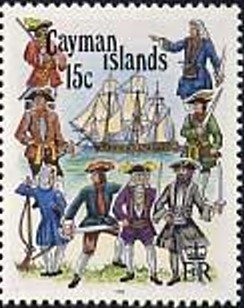Stamp: Pirates, Sailing Ship (Cayman Islands 1993)
Pirates, Sailing Ship (Cayman Islands 1993)
30 September (Cayman Islands ) within release Tourism goes into circulation Stamp Pirates, Sailing Ship face value 15 Cayman Islands cent
| Stamp Pirates, Sailing Ship in catalogues | |
|---|---|
| Stamp Number: | Sn:KY 666E |
Stamp is square format.
Also in the issue Tourism:
- Se-tenant - Strip of 5 face value 5*15;
- Stamp - Turtle, Sailboats face value 15;
- Stamp - Diver, Coral, Boats face value 15;
- Stamp - Golf face value 15;
- Stamp - Beach,Tennis face value 15;
- Stamp - Pirates, Sailing Ship face value 15;
- Se-tenant - Strip of 5 face value 5*30;
- Stamp - Cruise Ship, Boat,Sailboat face value 30;
- Stamp - City Street Scene face value 30;
- Stamp - Submarines face value 30;
- Stamp - Cyclist face value 30;
- Stamp - Jet planes face value 30;
- Booklet - Tourism face value 2.25;
Stamp Pirates, Sailing Ship it reflects the thematic directions:
A modern sailing ship or sailship is any large wind-powered vessel. Traditionally a sailing ship (or simply ship) is a sailing vessel that carries three or more masts with square sails on each. Large sailing vessels that are not ship-rigged may be more precisely referred to by their sail rig, such as schooner, barque (also spelled "bark"), brig, barkentine, brigantine or sloop. There are many different types of sailing ships, but they all have certain basic things in common. Every sailing ship has a hull, rigging and at least one mast to hold up the sails that use the wind to power the ship. The crew who sail a ship are called sailors or hands. They take turns to take the watch, the active managers of the ship and her performance for a period. Watches are traditionally four hours long. Some sailing ships use traditional ship's bells to tell the time and regulate the watch system, with the bell being rung once for every half hour into the watch and rung eight times at watch end (a four-hour watch). Ocean journeys by sailing ship can take many months, and a common hazard is becoming becalmed because of lack of wind, or being blown off course by severe storms or winds that do not allow progress in the desired direction. A severe storm could lead to shipwreck, and the loss of all hands. Sailing ships are limited in their maximum size compared to ships with heat engines, so economies of scale are also limited. The heaviest sailing ships (limited to those vessels for which sails were the primary means of propulsion) never exceeded 14,000 tons displacement. Sailing ships are therefore also very limited in the supply capacity of their holds, so they have to plan long voyages carefully to include many stops to take on provisions and, in the days before watermakers, fresh water.
Piracy is an act of robbery or criminal violence by ship or boat-borne attackers upon another ship or a coastal area, typically with the goal of stealing cargo and other valuable goods. Those who conduct acts of piracy are called pirates, and vessels used for piracy are called pirate ships. The earliest documented instances of piracy were in the 14th century BC, when the Sea Peoples, a group of ocean raiders, attacked the ships of the Aegean and Mediterranean civilisations. Narrow channels which funnel shipping into predictable routes have long created opportunities for piracy, as well as for privateering and commerce raiding.


